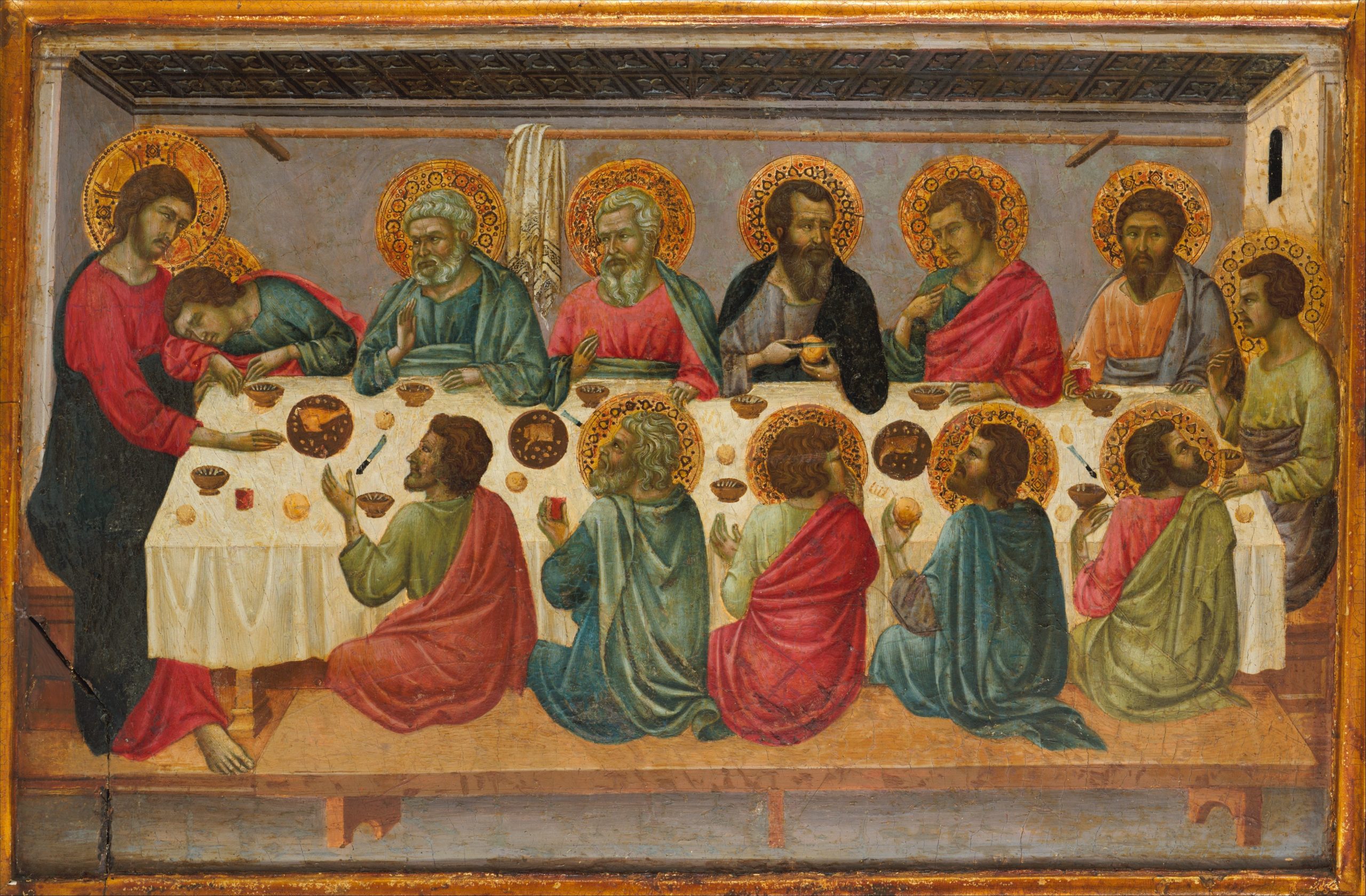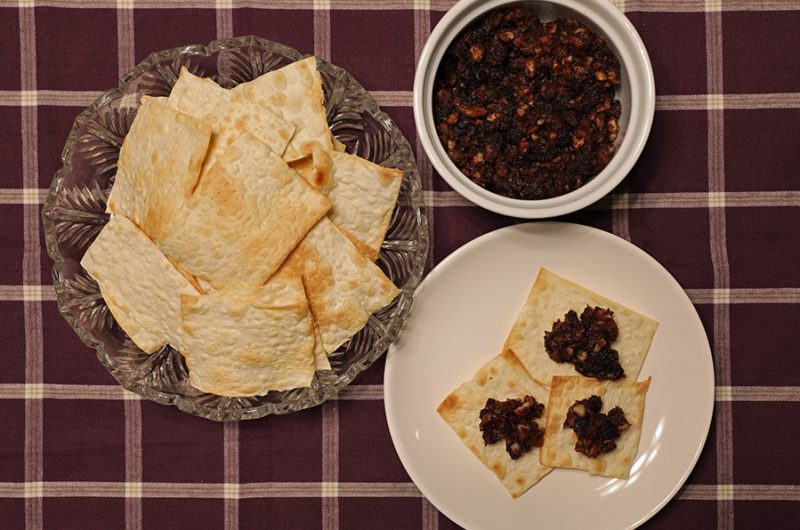
ABOUT THE ART
Ugolino da Siena, The Last Supper, ca. 1325–30, tempera and gold on wood, overall dimensions with engaged (modern) frame 15 x 22 1/4 in.; painted surface 13 1/2 x 20 3/4 in., Robert Lehman Collection, 1975, accession number 1975.1.7. New York. The Metropolitan Museum of Art.
Ugolino da Siena, a follower of the famous Sienese painter Duccio di Buoninsegna, was known for his exceptional painting skills. One of his major commissions was a multi-panel altarpiece for the high altar of the Franciscan church in Florence, Santa Croce. The Last Supper panel, which is now displayed individually, was originally a part of the predella, the lowest horizontal component of the altarpiece. The original appearance of the altarpiece can be reconstructed through an 18th-century drawing, which shows that the Last Supper panel was the left-most of seven predella panels. Ugolino’s workshop, which included his father and two brothers who were also painters, was quite large. In this painting, Christ is seen at the far left, informing his disciples that one of them will betray him, which was later fulfilled by Judas, who is seen without a halo at Christ’s right. Ugolino has reorganized the composition in a way similar to Giotto’s work in Santa Croce, and his exploration of spatial perspective is evident in details like the coffered ceiling and table settings.
The predella of the altarpiece also included six other panels: Arrest of Christ, Flagellation, Way to Calvary, Deposition, Entombment, and Resurrection. The main register displayed Saints John the Baptist, Paul, and Peter, while the intermediate upper register featured Saints James the Greater and Philip, Saints Matthew and James the Lesser, and Saints Matthias and Clare. The last two pairs of saints, Saints Simon and Thaddeus and Saints Bartholomew and Andrew, were displayed in the National Gallery, London. The fact that a follower of Duccio was commissioned to create an altarpiece for a major Florentine church is a testament to the popularity of Duccio’s work.
Maundy Thursday – Thursday of Holy Week
Thursday of Holy Week is where the story of Christ’s passion turns toward the cross. On this night, we remember Jesus gathering with his disciples in an upper room, celebrating Passover, and instituting the Lord’s Supper as a meal for his disciples. The Lord’s Supper or Eucharist is a meal of liberation, like Passover, with a focus on freedom from sin and death. Because Christ said that this meal was his body and blood, Christians all over the world experience the presence of Christ in tangible ways as they keep this feast. Most churches have a special Communion service on this day. The Gospel of John speaks to the other events that happened at the meal as well. Jesus washed the feet of the disciples and gave them his new and main commandment or teaching – to love one another. The sharing of this meal and the communal washing of feet show that the focus of this day and all of Holy Week is on love.
On this day, we recommend making haroset, which is a Middle Eastern treat of fruit, nuts, and spices ground into a paste. Haroset is an important part of the Jewish Seder meal, reminding the faithful of the mortar the Hebrew children used to lay Pharaoh’s bricks. While this part of the Seder meal does not date back to the time of Jesus, it is the type of food that Jesus and the disciples could have eaten at the Last Supper. It helps us tie the Lord’s Supper to the Passover in a powerful and sweet way. You may also make enough for it to be a side at Easter because Passover for Christians is Easter Sunday. We enjoy our haroset with a simple homemade cracker. Special food for these holy days is a great way to teach our children why “these nights are not like all the others” and focus on the central teaching of Jesus—love.

Haroset and Crackers
Keep the screen of your device on
Ingredients
- Haroset Ingredients
1 1/2 cups 1 1/2 red wine
2 1/2 cups 2 1/2 raisins
1 1/2 cups 1 1/2 dried dates, chopped
3/4 cup 3/4 dried apricots, chopped
1/2 teaspoon 1/2 cinnamon
1/4 teaspoon 1/4 ground cloves
1/2 teaspoon 1/2 salt
1 1/2 cups 1 1/2 roasted almonds
- Homemade Cracker Ingredients
4 1/2 cups 4 1/2 All-purpose Flour
1 teaspoon 1 salt
2 tablespoons 2 olive oil
3/4 cup 3/4 water (plus up to 1/2 cup additional warm water)
Directions
- Haroset Recipe
- Bring 1 1/2 cups red wine to a light simmer on medium heat, then stir in 2 1/2 cups raisins, 1 1/2 cups dried dates, 3/4 cup dried apricots, 1/2 teaspoon cinnamon, 1/4 teaspoon ground cloves, and 1/2 teaspoon salt.
- Cook uncovered for about 15 – 20 minutes or until fruit is well hydrated and wine has become a thick syrup. Add salt to taste and set aside.
- In a food processor, roughly chop the 1 1/2 cups roasted almonds using short pulses. No whole almonds should remain; medium and small chunks of almonds are preferable. Remove almonds from food processor and transfer to a large mixing bowl.
- Add the fruit mixture to the food processor and pulse until fruit just begins to come together into a paste, 2 to 3 one-second pulses. Be careful not to overprocess.
- Combine the almonds and fruit mixture in a mixing bowl. Stir well to combine. Enjoy with crackers.
- Homemade Cracker Recipe
- Preheat the oven with baking stone inside to 500°F. If you don’t have a baking stone, a regular baking sheet will also suffice.
- In a large bowl, mix together all the ingredients, starting with the least amount of water. The dough will at first be very crumbly. Slowly add additional water until the dough just starts to hold together. I find the best way to add water is to wet your hands and then knead the dough a little. If it needs more water, wet your hands again and continue mixing and kneading. It’s important to not make the dough too wet. Once the dough starts to hold together, knead for a few minutes and then form into a ball.
- Let the dough rest for 10 to 15 minutes.
- Divide the dough into 8 pieces. Flatten each piece slightly and pass it repeatedly through a pasta maker, if you have one. Reduce the thickness of the pasta maker each time until you eventually reach the thinnest setting. If you don’t have a pasta maker, roll the dough using a rolling pin, making it as thin as possible.
- Trim the rolled-out dough pieces into rectangles. Use a fork to poke holes in the surface of the dough.
- Carefully place a few of the rectangle dough pieces onto the preheated baking stone or baking sheet. Watch closely and bake until the surface of the cracker is golden brown and bubbly, between 30 to 90 seconds.
- Using tongs, carefully flip the cracker and continue to bake until the other side is golden browned and lightly blistered, 15 to 30 seconds.
- Let the crackers cool before serving.
- Repeat the process until all the dough is used.